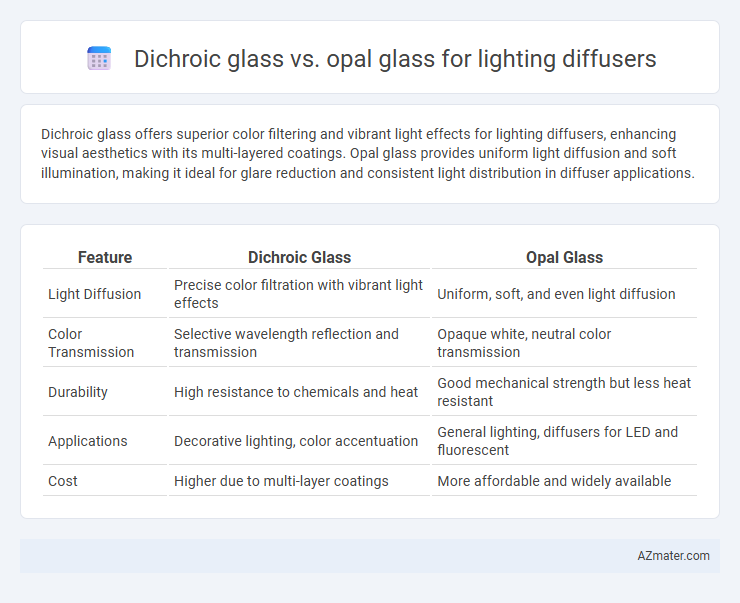Dichroic glass offers superior color filtering and vibrant light effects for lighting diffusers, enhancing visual aesthetics with its multi-layered coatings. Opal glass provides uniform light diffusion and soft illumination, making it ideal for glare reduction and consistent light distribution in diffuser applications.
Table of Comparison
| Feature | Dichroic Glass | Opal Glass |
|---|---|---|
| Light Diffusion | Precise color filtration with vibrant light effects | Uniform, soft, and even light diffusion |
| Color Transmission | Selective wavelength reflection and transmission | Opaque white, neutral color transmission |
| Durability | High resistance to chemicals and heat | Good mechanical strength but less heat resistant |
| Applications | Decorative lighting, color accentuation | General lighting, diffusers for LED and fluorescent |
| Cost | Higher due to multi-layer coatings | More affordable and widely available |
Introduction to Lighting Diffusers: Dichroic vs Opal Glass
Lighting diffusers enhance illumination quality by evenly distributing light and reducing glare, with dichroic and opal glass being popular material choices. Dichroic glass employs thin-film coatings to selectively reflect specific wavelengths, producing vibrant color effects and controlled light transmission, ideal for decorative and architectural lighting applications. Opal glass offers uniform diffusion through its milky, translucent surface, delivering soft, glare-free lighting suitable for general illumination and indoor spaces.
Material Composition and Manufacturing Process
Dichroic glass consists of multiple ultra-thin layers of metal oxides deposited on glass, producing selective light transmission and reflection through interference effects. Opal glass is made from a homogeneous blend of silica and opacifying agents such as bone ash or titanium dioxide, creating a diffuse, uniformly milky appearance by scattering light. Dichroic glass requires vacuum deposition techniques in a controlled environment, while opal glass is typically crafted through standard melting and blending processes during glassmaking.
Light Diffusion and Optical Performance
Dichroic glass offers precise light diffusion with the ability to selectively reflect and transmit specific wavelengths, enhancing color purity and optical performance in lighting diffusers. Opal glass provides a more uniform, soft light diffusion by scattering light, reducing glare and creating a smooth, even illumination ideal for general lighting applications. While dichroic glass excels in color control and spectral manipulation, opal glass delivers consistent diffusion with minimal color distortion.
Color Rendering and Visual Aesthetics
Dichroic glass offers superior color tuning and high color rendering index (CRI), enhancing vivid color accuracy in lighting applications compared to opal glass, which diffuses light more uniformly but with less color precision. The multi-layer coating of dichroic glass creates striking visual aesthetics through reflected and transmitted colors, providing dynamic effects ideal for artistic lighting. Opal glass delivers soft, muted light that reduces glare and creates a calming ambiance, making it preferable for settings requiring consistent and gentle illumination.
Energy Efficiency and Light Transmission
Dichroic glass offers superior energy efficiency in lighting diffusers by selectively reflecting unwanted wavelengths and transmitting desired light, which reduces heat and enhances illumination quality. Opal glass provides more uniform light diffusion but tends to absorb more light, lowering overall energy efficiency compared to dichroic glass. For applications prioritizing maximum light transmission and energy savings, dichroic glass is typically the preferred choice.
Durability and Maintenance Requirements
Dichroic glass offers superior durability for lighting diffusers due to its multi-layered coating that resists fading, scratching, and corrosion, ensuring long-lasting performance in various environments. Opal glass, while aesthetically pleasing with its soft diffused light, is more susceptible to surface damage and requires more frequent cleaning to maintain its visual clarity and light diffusion properties. Maintenance of dichroic glass diffusers is generally minimal, involving occasional dusting, whereas opal glass demands careful cleaning to avoid surface wear and discoloration over time.
Design Flexibility and Customization Options
Dichroic glass offers exceptional design flexibility through its multi-layered coatings that produce vibrant, shifting colors and precise light control, making it ideal for dynamic, artistic lighting diffusers. Opal glass provides a more uniform and diffused light output with customizable thickness and surface textures, offering versatility in achieving soft, evenly distributed illumination. Both materials support tailored aesthetic and functional applications, but dichroic glass excels in multi-color effects while opal glass is preferred for consistent light diffusion.
Cost Comparison: Initial Investment and Lifecycle
Dichroic glass generally requires a higher initial investment due to complex manufacturing processes involving multiple thin-film coatings, making it costlier than opal glass. Opal glass offers a more affordable upfront cost with easier production methods but may incur higher lifecycle expenses due to lower durability and potential need for more frequent replacements. Assessing total cost of ownership, dichroic glass's longer lifespan and enhanced light efficiency can offset its initial price, making it economically favorable over opal glass in long-term lighting applications.
Ideal Applications and Use Cases
Dichroic glass is ideal for architectural lighting and high-end decorative fixtures due to its precise color filtering and ability to create dynamic, reflective light effects. Opal glass excels as a diffuser in general illumination and residential lighting, providing uniform, soft light that reduces glare and enhances visual comfort. Both materials are suited for LED lighting, with dichroic glass emphasizing color customization and opal glass focusing on light diffusion and evenness.
Choosing the Right Glass Diffuser: Key Considerations
Dichroic glass offers vibrant color filtering and high durability, making it ideal for lighting diffusers where color effect and light direction control are essential. Opal glass, known for its uniform light diffusion and soft glow, suits applications requiring gentle, even illumination without glare. Choosing the right glass diffuser depends on factors like desired light quality, color rendering index (CRI), durability requirements, and aesthetic preferences for the lighting design.

Infographic: Dichroic glass vs Opal glass for Lighting diffuser
 azmater.com
azmater.com